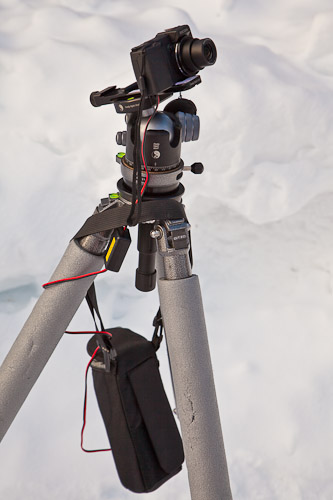Time-Lapse Recordings with the Ricoh GX200
Introduction
For time-lapse recordings, I acquired a Ricoh GX200. This small compact camera boasts an extraordinary range of features, and it's truly fantastic what Ricoh has packed into it. In addition to shooting RAW photos in the open DNG format, it offers manual exposure, manual white balance, and, most notably, an integrated intervalometer for time-lapse photography. Furthermore, the camera allows manual focusing. Using SDHC cards largely solves the storage problem. The lens is also well-suited for time-lapse filming, with a shortest focal length of 5.1mm (equivalent to 24mm in 35mm format), providing a good wide-angle for a compact camera. For those who need more, a supplementary lens can reduce the focal length to an equivalent of 19mm. On the other end, at 15.3mm (equivalent to 72mm in 35mm format), it doesn't quite reach telephoto range, but it's quite usable for many applications. With an additional lens, the focal length can be extended to an equivalent of 135mm. I'd like to mention the electronic level, which facilitates precise camera alignment. Lastly, you can program all settings on three different presets on the mode dial, which is especially practical for time-lapse configurations. Ingeniously, the camera offers an optionally available viewfinder that can be used as an alternative to the camera display. This is a very good option, especially in bright sunlight, and the electronic viewfinder is considerably brighter than the often-encountered tiny viewfinders on compact cameras. Moreover, all data displayed on the screen is also shown in the electronic viewfinder.
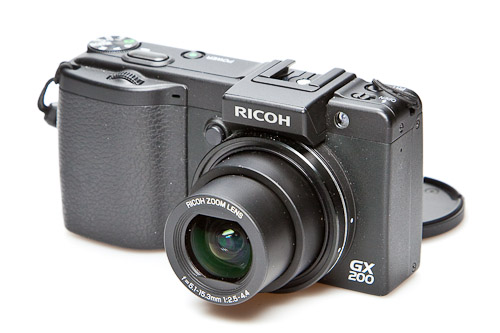
Settings During Recording
The intervalometer can be set in 5-second increments, ranging from a minimum of 5 seconds to a maximum of 3 hours. The smallest interval is not particularly short, but the camera also needs some time to save the images to the memory card. I assume that's why the interval is set to a minimum of 5 seconds. So, you don't have the same functionality as with an SLR (Single Lens Reflex, single-lens reflex camera) with an external timer that can be set down to one second. However, the entire camera is much more compact, and most importantly, the timer or intervalometer is already integrated into the camera. With an interval of 5 seconds and a later frame rate of 25 frames per second in the video, you always have a minimum acceleration factor or time-lapse factor of 125: The events are replayed 125 times faster in the final film than they were actually recorded. In other words, 1 hour is replayed in 30 seconds.
As described in the article on time-lapse films, you set the exposure manually and, if necessary, fix the white balance. However, this is not as critical, as the steps in white balance are much smaller, and a change in white balance during the short film is not disturbing, in contrast to exposure changes.
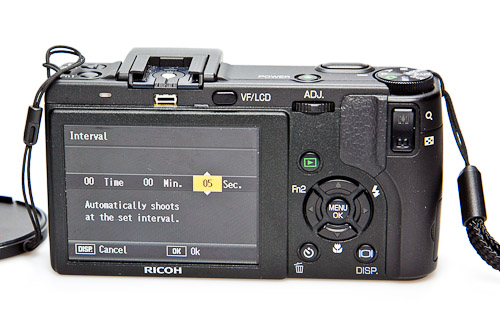
Power Consumption
For time-lapse films, power consumption is crucial for the maximum film length. The more shots possible with a single battery charge, the longer the film that can be assembled later. A battery change is practically impossible during the shooting sequence because the tripod adapter is very close to the battery compartment. So, the camera must be unscrewed from the tripod for a battery change. Additionally, the timer is reset in the event of a power outage, so it must be set again. Thus, there may be difficulties in precisely remounting the camera on the tripod after this procedure to avoid visible shifts in the final film.
Ricoh itself states that with the standard battery, a Li-Ion battery with 1150mAh, up to 350 shots are
possible. However, this information should be taken with caution, as the display is the major power consumer,
and the duration the display is on for each shot is crucial. I obtained quite different results after various
attempts:
Attempt 1, two films, a total of 992 shots with one battery charge
Film 1: Interval 5sec., 485 shots
Film 2: Interval 5sec, 507 shots
Attempt 2, two films, a total of 703 shots with one battery charge
Film 1: Interval 5 sec. 602 shots
Film 2: Interval 120sec., 60sec. exposures, 101 shots
Attempt 3, one film, Interval 5sec, a total of 737 shots with one battery charge
Attempt 4, one film, Interval 10sec, without the viewfinder, 1179 shots with one battery charge
All attempts were made at outdoor temperatures around zero degrees Celsius. So, there may be an improvement at temperatures around 20 degrees Celsius. Depending on the battery, this effect can mean up to twice as many shots at room temperature relative to the zero-point. At the moment (March 2010), it is still too cold to verify this.
Apparently, the interval time has an influence. Exposure time also negatively affects battery life. The display was always turned off, and in the last attempt, the electronic viewfinder was also removed. To investigate the issue of power consumption, I measured the camera. The battery was disassembled, and a current meter (multimeter) was connected in between.
Power Consumption Ricoh GX200:
- Without electronic viewfinder, display deactivated: 280mA
- With electronic viewfinder, display deactivated: 350mA
- Display activated (the electronic viewfinder is automatically turned off): 360mA
- Autofocus: 580ms (<1sec)
- Shutter release: approx. 400mA (<1sec)
- Image review: 140-150mA
- Delete: 220mA (<1sec)
- ON (Boot phase): approx. 530mA
- OFF: approx. 400mA
Activating the electronic level and vibration reduction (Shake Reduction) has no measurable effect. Unlike the interval tests above, the various power values were measured at room temperature.
The high power consumption of the camera when the electronic viewfinder and the display are turned off is surprising. One would expect that the camera draws no power in this state, and I was therefore surprised that the difference compared to operation with the display turned on was rather small. So, one must count on a continuous power consumption of at least 280mA. Power consumption is calculated not only based on the number of shots but above all on the absolute operating time. Autofocus, which causes a short-term high current flow, is deactivated during interval shooting.
For a 5-second interval, there are 720 shots per hour. If you use the electronic viewfinder, the camera consumes 350mAh during this time, even without taking any shots. With a 1150mAh battery, you would, therefore, be able to operate the camera for about 3 hours. Now you still have to consider the exposures. Since power consumption during shooting only increases for a very short time, the impact should not be too high with an exposure every 5 seconds. The theoretically calculated and practically measured values, however, differ significantly. This is very likely due to the temperature effect mentioned earlier.
Therefore, one should keep power consumption during shooting as low as possible. This means:
- Deactivate the display
- Remove the electronic viewfinder
- Turn off autofocus
For longer shooting sequences, an external power supply must be used.
External Power Supply
Ricoh offers an extensive range of additional options for the GX200. Here you will also find an external power supply for operation on AC power, i.e., from the outlet. However, in the field, you will not always find an outlet, which is why I decided to design a more flexible adapter for the GX200 that can be operated either on the outlet or an external battery. As explained in the article on the external power supply for the Canon 20D, you can easily use a voltage converter or voltage regulator (also called a line regulator) here. Such simple components regulate the output voltage very precisely, but the current flowing over the voltage difference is converted into heat. In the case of the Canon 20D, the camera voltage is 8VDC, and when operating at 12VDC, it is regulated down by 4VDC. However, the Canon only consumes 45mA in standby mode, so this loss is not so critical. With the Ricoh GX200, the camera voltage is only 3.7VDC, less than half, and the standby power consumption is at least 280mA, more than six times. Therefore, the power loss is more than 12 times higher than with the 20D. As a result, the components also get quite hot, as up to 3.7VDC, i.e., over 8.3VDC at 280mA, are converted into heat. I built such a converter with two cascaded voltage regulators to distribute the heat to two components. The voltage is first reduced to 6VDC with a fixed-voltage regulator and then regulated to exactly 3.7VDC with an adjustable voltage regulator of the LM317 type. At the first component, 6VDC or 1.7W is lost, and at the second, 2.3VDC or 0.6W. It works, but as mentioned, the power loss is considerable.
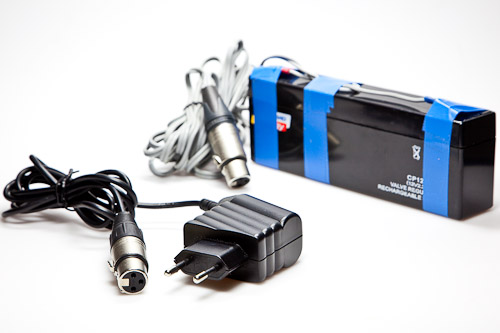
If I now use a lead-acid battery with 12VDC and 2.3Ah, the camera itself has about twice the power available compared to the standard battery, which delivers 1150mAh at 3.7VDC. However, the lead-acid battery weighs 950g, which is 38 times the weight of the standard battery (25g). So, the efficiency of this approach is not very impressive. With the 38 times greater weight, only twice as many shots can be taken.
Fortunately, there is another approach. Instead of using a voltage converter, one uses a switching regulator. These components transform the voltage, for example, via pulse-width modulation, and the efficiency is very high with these components. For example, the Recom R-78A5.0-0.5SMD has an efficiency of 94%, and its standard output voltage of 5.0VDC can be adjusted in the range of 2.5-8.0VDC via external resistors. So, if the camera consumes about 1W in standby (280mA at 3.7VDC), the power loss of the switching regulator is about 60mW. Now, if you compare operating with a lead-acid battery with operating with the standard battery, the situation looks much better. The lead-acid battery has a capacity of 2.3Ah at 12VDC, so 27.6Wh. After the voltage transformation, there are still 25.94Wh available due to the switching regulator losses, i.e., 7Ah at 3.7VDC, which is 6 times more than with the internal battery.
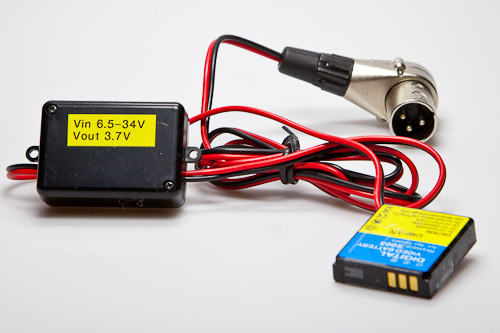

Experiences
With the new external power supply, very long series can be recorded. An external lead-acid battery, as described above, or a direct connection to an outlet via a 12VDC power supply can be used alternatively. I have made several series up to 3000 shots to date, and the power supply works perfectly. Even at temperatures down to -25°C, the unit was tested in the Finnish winter. The Ricoh does its job very quietly and therefore does not attract much attention. Unfortunately, with the Ricoh, you cannot set smaller RAW formats but always have to work with the maximum resolution of about 12 megapixels (in three selectable formats); that is the only downside. For this reason, in lighting situations that produce an acceptable histogram, I work with a jpg setting and can significantly reduce the data volume. So, the maximum resolution of the GX200 is already too high for time-lapse film recording, and a reduced RAW format would be desirable. Otherwise, thanks to the "My" settings on the mode dial, the camera can be configured very comfortably for time-lapse use and is correspondingly quick with the correct settings.
